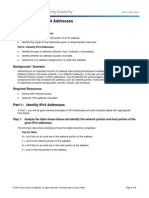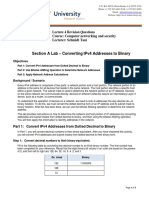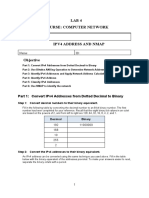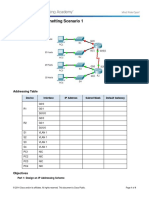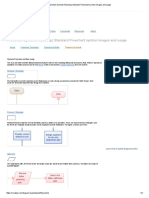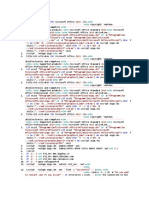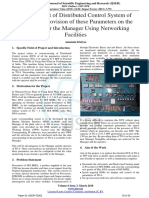8.1.4.8 Lab Respuestas
8.1.4.8 Lab Respuestas
Uploaded by
Jesús David DíazCopyright:
Available Formats
8.1.4.8 Lab Respuestas
8.1.4.8 Lab Respuestas
Uploaded by
Jesús David DíazCopyright
Available Formats
Share this document
Did you find this document useful?
Is this content inappropriate?
Copyright:
Available Formats
8.1.4.8 Lab Respuestas
8.1.4.8 Lab Respuestas
Uploaded by
Jesús David DíazCopyright:
Available Formats
L
Lab Ide
entifying
g IPv4 Addresse
A
es
O
Objectives
Part 1: Identify IPv4 Addresses
A
ortion of an IP
P address.
Identify the networrk and host po
Identify the range of
o host addres
sses given a network/prefiix mask pair.
A
Part 2: Cllassify IPv4 Addresses
Identify the type off address (nettwork, host, multicast,
m
or b
broadcast).
Identify whether an
n address is public
p
or priva
ate.
Deterrmine if an address assignm
ment is a valid host addresss.
B
Backgroun
nd / Scenarrio
Addressin
ng is an imporrtant function of network la
ayer protocolss because it e
enables data ccommunicatio
on
between hosts
h
on the same
s
network
k, or on differe
ent networks.. In this lab, yyou will examiine the structu
ure of
Internet Protocol
P
versio
on 4 (IPv4) ad
ddresses. You
u will identify the various tyypes of IPv4 a
addresses an
nd the
componen
nts that help comprise
c
the address, suc
ch as networkk portion, hostt portion, and subnet maskk. Types
of address
ses covered include
i
public
c, private, unic
cast, and mu lticast.
R
Required Resources
R
Devic
ce with Interne
et access
Optional: IPv4 address calculato
or
P
Part 1: Id
dentify IP
Pv4 Addre
esses
In Part 1, you will be giiven several examples
e
of IPv4 addresse
es and will co
omplete tabless with approp
priate
informatio
on.
S
Step 1: An
nalyze the ta
able shown below and identify the
e network p
portion and host portio
on of the
giv
ven IPv4 addresses.
The first tw
wo rows show
w examples of
o how the tab
ble should be completed.
Key for
f table:
N = all 8 bits for an
n octet are in the
t network portion
p
of the address
n = a bit in the netw
work portion of
o the address
s
H = all 8 bits for an
n octet are in the
t host portion of the add
dress
h = a bit in the host portion of th
he address
2013 Cisco and
d/or its affiliates. All rights reserve
ed. This docume
ent is Cisco Publiic.
Page 1 of 4
Lab Identifying IPv4 Addresses
Network/Host
N,n = Network
IP Address/Prefix
H,h = Host
Subnet Mask
Network Address
192.168.10.10/24
N.N.N.H
255.255.255.0
192.168.10.0
10.101.99.17/23
N.N.nnnnnnnh.H
255.255.254.0
10.101.98.0
209.165.200.227/27
172.31.45.252/24
10.1.8.200/26
172.16.117.77/20
N.N.N.nnnhhhhh
255.255.255.224 209.165.200.224
N.N.N.H
255.255.255.0
172.31.45.0
N.N.N.nnhhhhhh
255.255.255.192
10.1.8.192
N.N.N.nnnnhhhh.H 255.255.240.0
172.16.112.0
10.1.1.101/25
N.N.N.nhhhhhhh
255.255.255.128
10.1.1.0
209.165.202.140/27
N.N.N.nnnhhhhh
255.255.255.224 209.165.202.128
192.168.28.45/28
N.N.N.nnnnhhhh
255.255.255.240
192.168.28.32
Step 2: Analyze the table below and list the range of host and broadcast addresses given a
network/prefix mask pair.
The first row shows an example of how the table should be completed.
IP Address/Prefix
192.168.10.10/24
10.101.99.17/23
209.165.200.227/27
172.31.45.252/24
10.1.8.200/26
172.16.117.77/20
10.1.1.101/25
209.165.202.140/27
192.168.28.45/28
First Host Address
192.168.10.1
10.101.98.1
209.165.200.225
Last Host
Address
192.168.10.254
10.101.99.254
Broadcast
Address
192.168.10.255
10.101.99.255
209.165.200.254 209.165.200.255
172.31.45.1
172.31.45.254
172.31.45.255
10.1.8.193
10.1.8.254
10.1.8.255
172.16.112.1
10.1.1.1
209.165.202.129
192.168.28.33
172.16.127.254 172.16.127.255
10.1.1.126
10.1.1.127
209.165.202.158 209.165.202.159
192.168.28.46
192.168.28.47
Part 2: Classify IPv4 Addresses
In Part 2, you will identify and classify several examples of IPv4 addresses.
Step 1: Analyze the table shown below and identify the type of address (network, host,
multicast, or broadcast address).
The first row shows an example of how the table should be completed.
2013 Cisco and/or its affiliates. All rights reserved. This document is Cisco Public.
Page 2 of 4
Lab Identifying IPv4 Addresses
IP Address
Subnet Mask
Address Type
10.1.1.1
255.255.255.252
host
192.168.33.63
255.255.255.192
broadcast
239.192.1.100
255.252.0.0
host
172.25.12.52
255.255.255.0
host
10.255.0.0
255.0.0.0
host
172.16.128.48
255.255.255.240
network
209.165.202.159
255.255.255.224
broadcast
172.16.0.255
255.255.0.0
host
224.10.1.11
255.255.255.0
host
Step 2: Analyze the table shown below and identify the address as public or private.
IP Address/Prefix
Public or Private
209.165.201.30/27
Public
192.168.255.253/24
Privada
10.100.11.103/16
Privada
172.30.1.100/28
Privada
192.31.7.11/24
Privada
172.20.18.150/22
Privada
128.107.10.1/16
Pblica
192.135.250.10/24
Privada
64.104.0.11/16
Pblica
Step 3: Analyze the table shown below and identify whether the address/prefix pair is a valid
host address.
2013 Cisco and/or its affiliates. All rights reserved. This document is Cisco Public.
Page 3 of 4
Lab Identifying IPv4 Addresses
IP Address/Prefix
Valid Host Address?
Reason
127.1.0.10/24
Si
...1 - ...254
172.16.255.0/16
..0.1 - ..255.254
241.19.10.100/24
Si
...1 - ...254
192.168.0.254/24
Si
...1 - ...254
192.31.7.255/24
No. Broadcast
...1 - ...254
64.102.255.255/14
Si
..0.1 - ..255.254
224.0.0.5/16
Si
..0.1 - ..255.254
10.0.255.255/8
Si
..0.1 - ..255.254
198.133.219.8/24
Si
...1 - ...254
Reflection
Why should we continue to study and learn about IPv4 addressing if the available IPv4 address space is
depleted?
2013 Cisco and/or its affiliates. All rights reserved. This document is Cisco Public.
Page 4 of 4
You might also like
- Network Security All-in-one: ASA Firepower WSA Umbrella VPN ISE Layer 2 SecurityFrom EverandNetwork Security All-in-one: ASA Firepower WSA Umbrella VPN ISE Layer 2 SecurityNo ratings yet
- 7.1.4.9 Lab - Identifying IPv4 AddressesDocument3 pages7.1.4.9 Lab - Identifying IPv4 AddressesEduardo Haro38% (16)
- CCNA Workbook by NETWORKERS HOMEDocument144 pagesCCNA Workbook by NETWORKERS HOMERama Karvil100% (2)
- IPv4 Subnetting for Beginners: Your Complete Guide to Master IP Subnetting in 4 Simple Steps: Computer Networking, #1From EverandIPv4 Subnetting for Beginners: Your Complete Guide to Master IP Subnetting in 4 Simple Steps: Computer Networking, #1Rating: 5 out of 5 stars5/5 (3)
- Berkeley ManualDocument24 pagesBerkeley ManualFernando OseguedaNo ratings yet
- 8.1.4.8 Lab - Identifying IPv4 Addresses PDFDocument4 pages8.1.4.8 Lab - Identifying IPv4 Addresses PDFAzizNugrohoNo ratings yet
- 7.1.4.9 Lab - Identifying IPv4 AddressesDocument3 pages7.1.4.9 Lab - Identifying IPv4 Addressesرافد البركي50% (2)
- 8.1.4.8 Lab - Identifying IPv4 AddressesDocument4 pages8.1.4.8 Lab - Identifying IPv4 AddressesdotcomblaNo ratings yet
- 8.1.4.8 Lab - Identifying IPv4 Addresses-1Document3 pages8.1.4.8 Lab - Identifying IPv4 Addresses-1Luis Renato GarciaNo ratings yet
- 8.1.4.8 Lab - Identifying IPv4 Addresses PDFDocument4 pages8.1.4.8 Lab - Identifying IPv4 Addresses PDFErnestoPérezNo ratings yet
- 8.1.4.8 Lab - Identifying IPv4 AddressesDocument4 pages8.1.4.8 Lab - Identifying IPv4 Addressesjeffrewh0% (1)
- 8.1.4.8 Lab - Identifying IPv4 AddressesDocument4 pages8.1.4.8 Lab - Identifying IPv4 Addresseseasyspot57% (35)
- 7.1.4.9 Lab - Identifying IPv4 AddressesDocument4 pages7.1.4.9 Lab - Identifying IPv4 AddressesParthPatel50% (10)
- Praktikum Modul 7 IPv4 Dan IPv6Document20 pagesPraktikum Modul 7 IPv4 Dan IPv6Joshia Agrisa Anrhiely LutherNo ratings yet
- Lecture 6 - IP Addressing and SubnettingDocument101 pagesLecture 6 - IP Addressing and SubnettingJianna ElishaNo ratings yet
- Mod6 IP AddressingDocument92 pagesMod6 IP AddressingCode With MeNo ratings yet
- Acn Imp Q&aDocument72 pagesAcn Imp Q&acasexi3151No ratings yet
- Ch-4 Internetworking IP Planning - FinalDocument35 pagesCh-4 Internetworking IP Planning - Finalfasilgirma.111No ratings yet
- Subnetting LabDocument5 pagesSubnetting LabBruno BandinaNo ratings yet
- Assignment 2Document8 pagesAssignment 2Wilfried KamahaNo ratings yet
- IP Addressing and SubnetingDocument8 pagesIP Addressing and SubnetingUsama IbrahimNo ratings yet
- Salesian Polytechnical University Systems Engineering: Networks IiDocument8 pagesSalesian Polytechnical University Systems Engineering: Networks Iisony_w200No ratings yet
- Data Communication and Networking IP Addressing Sub NetworksDocument4 pagesData Communication and Networking IP Addressing Sub NetworksNelumNo ratings yet
- Labotratory Activity 7 A - Ip Addressing Basics PDFDocument4 pagesLabotratory Activity 7 A - Ip Addressing Basics PDFjurilyn alvadorNo ratings yet
- Lab 6 IPv4 and NMAP - enDocument6 pagesLab 6 IPv4 and NMAP - enHoàng DuyNo ratings yet
- IP AddressingDocument19 pagesIP Addressingvishalpalv43004No ratings yet
- Lab 05Document10 pagesLab 05نیان سیف باٹھNo ratings yet
- Aditya Modul5 Prak KomdatDocument17 pagesAditya Modul5 Prak KomdatAditya NugrahaNo ratings yet
- CommNet LabExperimentsDocument12 pagesCommNet LabExperimentsEfka DxNo ratings yet
- ReS1.08 IP ADDRESSING ARCHITECTUREDocument14 pagesReS1.08 IP ADDRESSING ARCHITECTUREHisham MohamedNo ratings yet
- CCN Lab 5Document17 pagesCCN Lab 5sameen khanNo ratings yet
- CN Lab FileDocument27 pagesCN Lab Fileananyajme8No ratings yet
- Introduction To Ip Address, Mac Address and ' Packet Tracer ObjectiveDocument7 pagesIntroduction To Ip Address, Mac Address and ' Packet Tracer Objectivezain islamNo ratings yet
- HW 5 Solutions - COSC4377 - SP18 v2 PDFDocument14 pagesHW 5 Solutions - COSC4377 - SP18 v2 PDFMatt mNo ratings yet
- 9.1.4.6 Packet Tracer - Subnetting Scenario 1 InstructionsDocument4 pages9.1.4.6 Packet Tracer - Subnetting Scenario 1 InstructionsJonny MonteroNo ratings yet
- IP Addressing and SubnettingDocument36 pagesIP Addressing and SubnettingRhy Obra100% (2)
- Ahtisham 1042 Lab3-DCNDocument7 pagesAhtisham 1042 Lab3-DCNAhMed HafeezNo ratings yet
- Computer Network PracticalDocument20 pagesComputer Network PracticalSaurabh SinghNo ratings yet
- LAB 4 Diagnostic Utilities of NetworkDocument12 pagesLAB 4 Diagnostic Utilities of Networkali haiderNo ratings yet
- Networking Part 2Document17 pagesNetworking Part 2Anish GhuiNo ratings yet
- Mcit - Ethio Joint Team Training MaterialDocument56 pagesMcit - Ethio Joint Team Training MaterialMuhammedYeshaw67% (3)
- CCNA Identifying and Configuring IPv4 and IPv6 AddressesDocument10 pagesCCNA Identifying and Configuring IPv4 and IPv6 AddressesAbo AssemNo ratings yet
- Chap AssignmentDocument6 pagesChap Assignmentlazer155No ratings yet
- Learning Activity Sheet In: Computer Systems ServicingDocument12 pagesLearning Activity Sheet In: Computer Systems ServicingCarvalds 0315100% (1)
- Research Paper Ip AddressDocument4 pagesResearch Paper Ip Addressgz46ktxr100% (1)
- 8.2.5.4 Lab - Identifying IPv6 AddressesDocument10 pages8.2.5.4 Lab - Identifying IPv6 Addressesasdfjkl100% (1)
- Lab Activity No. 2Document15 pagesLab Activity No. 2cruzxander680No ratings yet
- NetLab-L2 3Document19 pagesNetLab-L2 3aloqab778030No ratings yet
- NETW202 Lab/Assignment Worth 55 Points WK 2 Lab Answer SheetDocument9 pagesNETW202 Lab/Assignment Worth 55 Points WK 2 Lab Answer SheetOmar TorresNo ratings yet
- Chapter 8: TCP/IP Internetworking IDocument10 pagesChapter 8: TCP/IP Internetworking IShd SnsNo ratings yet
- Acn Assignment FinalDocument13 pagesAcn Assignment Finalhackermh862No ratings yet
- 9.1.4.6 Packet Tracer - Subnetting Scenario 1 InstructionsDocument4 pages9.1.4.6 Packet Tracer - Subnetting Scenario 1 InstructionsRadu Florin TriponNo ratings yet
- TCP/IP: Network+ Protocols And Campus LAN Switching FundamentalsFrom EverandTCP/IP: Network+ Protocols And Campus LAN Switching FundamentalsNo ratings yet
- CCNA Certification All-in-One For DummiesFrom EverandCCNA Certification All-in-One For DummiesRating: 5 out of 5 stars5/5 (1)
- Linux for Networking Professionals: Securely configure and operate Linux network services for the enterpriseFrom EverandLinux for Networking Professionals: Securely configure and operate Linux network services for the enterpriseNo ratings yet
- Wireless and Mobile Hacking and Sniffing TechniquesFrom EverandWireless and Mobile Hacking and Sniffing TechniquesNo ratings yet
- Practical Internet Server Configuration: Learn to Build a Fully Functional and Well-Secured Enterprise Class Internet ServerFrom EverandPractical Internet Server Configuration: Learn to Build a Fully Functional and Well-Secured Enterprise Class Internet ServerNo ratings yet
- Unit-3 Relational Database ManagementDocument21 pagesUnit-3 Relational Database ManagementGNo ratings yet
- Digital Marketing Report Sip ShubhamDocument28 pagesDigital Marketing Report Sip ShubhamLavesh SethiaNo ratings yet
- Cosmetic Wholesale and Delivery Management System PDFDocument167 pagesCosmetic Wholesale and Delivery Management System PDFAbdullah AdvanyNo ratings yet
- Top-Down Network Design: Chapter SixDocument50 pagesTop-Down Network Design: Chapter SixyogaNo ratings yet
- Minor Project Progress Report: "Gym Website"Document19 pagesMinor Project Progress Report: "Gym Website"Sumit SethiNo ratings yet
- Flowchart Symbols Meaning - Standard Flowchart Symbol Images and UsageDocument4 pagesFlowchart Symbols Meaning - Standard Flowchart Symbol Images and UsageYudikaWisnuPratomoNo ratings yet
- 6th Sem Vtu ResultDocument1 page6th Sem Vtu Resultsampath rajannaNo ratings yet
- Milk Management SystemDocument18 pagesMilk Management Systemchristopher davasekaranNo ratings yet
- ID3 AlgorithmDocument11 pagesID3 AlgorithmHayat RajaniNo ratings yet
- (X) (2023) (Corneal Localization For Discening Faces Using Advanced Machine Learning Algorithms of GAN) (Articulo)Document5 pages(X) (2023) (Corneal Localization For Discening Faces Using Advanced Machine Learning Algorithms of GAN) (Articulo)m23ce070No ratings yet
- Acer Aspire Es1-531 Domino - Ba 14285-1 (Diagramas - Com.br)Document102 pagesAcer Aspire Es1-531 Domino - Ba 14285-1 (Diagramas - Com.br)jorgeNo ratings yet
- Zimbra NE Admin Guide 8.0.2Document342 pagesZimbra NE Admin Guide 8.0.2710507No ratings yet
- 95-06360 REV. J INSERT-Epic 950 Spare Parts GuideDocument30 pages95-06360 REV. J INSERT-Epic 950 Spare Parts GuideSTEVEN WUNo ratings yet
- ARM Cortex M4Document27 pagesARM Cortex M4Gurram KishoreNo ratings yet
- Ernst-Young-2012 Global Information Security SurveyDocument8 pagesErnst-Young-2012 Global Information Security SurveytomikeroNo ratings yet
- Semi Supervised Machine Learning Approach For DDOS DetectionDocument6 pagesSemi Supervised Machine Learning Approach For DDOS DetectionTunnu SunnyNo ratings yet
- Varun Tyagi CVDocument2 pagesVarun Tyagi CVapi-258578953No ratings yet
- Project Synopsis TemplateDocument4 pagesProject Synopsis TemplateAzl104No ratings yet
- How To Triple Your Sales by Getting Your Internet Marketing RightDocument176 pagesHow To Triple Your Sales by Getting Your Internet Marketing RightA. LópezNo ratings yet
- New Microsoft Word DocumentDocument3 pagesNew Microsoft Word DocumentpradeepNo ratings yet
- Analiza R. BellezaDocument3 pagesAnaliza R. BellezaFrancisco GalvezNo ratings yet
- Descriptive Analysis in R Programming - GeeksforGeeks-1-12Document12 pagesDescriptive Analysis in R Programming - GeeksforGeeks-1-12Sudhanshu JhaNo ratings yet
- Jenkins 1707984653Document70 pagesJenkins 1707984653WafaNo ratings yet
- Bay of Bengal and South Asia Air Traffic Flow Management HandbookDocument31 pagesBay of Bengal and South Asia Air Traffic Flow Management Handbookramret100% (1)
- Case Study On Flip Cart-WTEDocument3 pagesCase Study On Flip Cart-WTEKenam JainNo ratings yet
- Bugreport Miel - Global SP1A.210812.016 2023 09 23 05 48 54 Dumpstate - Log 28099Document28 pagesBugreport Miel - Global SP1A.210812.016 2023 09 23 05 48 54 Dumpstate - Log 28099estefanyapaza9No ratings yet
- Replacement of Distributed Control System of TG - 4 and Provision of These Parameters On The System Near The Manager Using Networking FacilitiesDocument3 pagesReplacement of Distributed Control System of TG - 4 and Provision of These Parameters On The System Near The Manager Using Networking FacilitiesGunadevan ChandrasekaranNo ratings yet
- ZARA Inc. Canada: Aditi TyagiDocument10 pagesZARA Inc. Canada: Aditi TyagiJayalNo ratings yet











